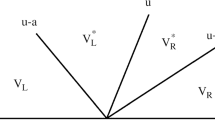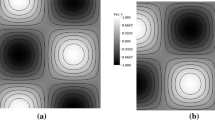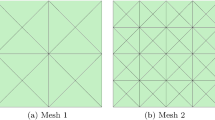Abstract
Accurate simulation of vortex-dominated flows has been an important issue for numerical methods in computational fluid dynamics. The recently proposed dual-solver framework provides an attracting direction for complex vortex structure resolving. In current research, we develop a dual-solver fluid solving system, in which the near-body region uses traditional finite volume method for complex geometries treatment, and apply high-order flux reconstruction (FR) method in off-body region to capture the evolution of vortex structures effectively. The parallel overset grid method is adopted in mesh assembly and data exchange process between solvers. The FR solver is developed under the framework of open-source adaptive mesh refinement (AMR) library p4est, which manages h-refinement efficiently. Cartesian cell with AMR is used in FR scheme to improve solving performance. The time marching method of coupled solvers is investigated. All modules in current system are verified, respectively. In the simulations where flow is dominated by vortex, we choose NACA0015 and S76 rotor wake resolving to verify the proposed system. The results reveal that the flow solver accurately resolves the vortex, the mesh distribution with AMR is reasonable. The results confirm the efficacy of proposed dual-solver framework.






























Similar content being viewed by others
References
Sitaraman, J., Potsdam, M., Wissink, A., et al.: Rotor loads prediction using Helios: a multisolver framework for rotorcraft aeromechanics analysis. J. Aircr. 50, 478–492 (2013)
Wissink, A.M., Jayaraman, B., Sitaraman, J.: An assessment of the dual-mesh paradigm using different near-body solvers in Helios. In: AIAA-2017-0287
Lakshminarayan, V., Sitaraman, J., Wissink, A.: Sensitivity of rotorcraft hover predictions to mesh resolution in strand grid framework. AIAA J. 56, 1–12 (2018)
Kirby, A.C., Brazell, M., Yang, Z., et al.: Wind farm simulations using an overset hp-adaptive approach with blade-resolved turbine models. In: AIAA-2017-3958
Kara, K., Brazell, M.J., Kirby, A.C., et al.: Hover predictions using a high-order discontinuous Galerkin off-body discretization. In: AIAA 2020-0771. AIAA Scitech 2020 Forum. January 2020
Abras, J., Hariharan, N.S.: Comparison of CFD hover predictions on the S-76 rotor. In: AIAA 2015-1711. 53rd AIAA Aerospace Sciences Meeting. January 2015
Wissink, A.M., Jude, D., Jayaraman, B., et al.: New capabilities in CREATE-AV Helios version 11. In: AIAA 2021-0235. AIAA Scitech 2021 Forum. January 2021
Witherden, F.D., Jameson, A.: Future directions in computational fluid dynamics. In: AIAA-2017-3791
Galbraith, M.C., Benek, J.A., Orkwis, P.D., et al.: A discontinuous Galerkin chimera scheme. Comput. Fluids 98, 27–53 (2014)
Yang, L., Yang, A.: Implementation of spectral difference method on overset grids for compressible inviscid flows. Comput. Fluids 140, 500–511 (2016)
Brazell, M.J., Kirby, A.C., Mavriplis, D.: A high-order discontinuous-Galerkin octree-based AMR solver for overset simulations. In: AIAA-2017-3944
Merrill, B.E., Peet, Y.T., Fischer, P.F., et al.: A spectrally accurate method for over-lapping grid solution of incompressible Navier–Stokes equations. J. Comput. Phys. 307, 60–93 (2016)
Kirby, A.C., Yang, Z., Mavriplis, D.J., et al.: Visualization and data analytics challenges of large-scale high-fidelity numerical simulations of wind energy applications. In: AIAA-2018-1171
Huynh, H.T.: A Flux reconstruction approach to high-order schemes including discontinuous Galerkin methods. In: AIAA-2007-4079
Asthana, K., Watkins, J., Jameson, A.: On the rate of convergence of flux reconstruction for steady-state problems. SIAM J. Numer. Anal. 54, 2910–2937 (2016)
Vincent, P.E., Castonguay, P., Jameson, A.: A new class of high-order energy stable flux reconstruction schemes. J. Sci. Comput. 47, 50–72 (2011)
Williams, D.M., Castonguay, P., Vincent, P.E., et al.: Energy stable flux reconstruction schemes for advection-diffusion problems on triangles. J. Comput. Phys. 250, 53–76 (2013)
Williams, D.M., Jameson, A.: Energy stable flux reconstruction schemes for advection- diffusion problems on tetrahedra. J. Sci. Comput. 59, 721–759 (2014)
Wang, Z.J., Li, Y., Jia, F., et al.: Towards industrial large eddy simulation using the FR/CPR method. Comput. Fluids 156, 579–589 (2017)
Vermeire, B.C., Witherden, F.D., Vincent, P.E.: On the utility of GPU accelerated high-order methods for unsteady flow simulations: a comparison with industry-standard tools. J. Comput. Phys. 334, 497–521 (2017)
Vermeire, B.C., Vincent, P.E.: On the behavior of fully-discrete flux reconstruction schemes. Comput. Methods Appl. Mech. Eng. 315, 1053–1079 (2017)
Crabill, J.A., Sitaraman, J., Jameson, A.: A high-order overset method on moving and deforming grids. In: AIAA-2016-3225
Duan, Z., Wang, Z.J.: High order FR/CPR method for overset meshes. In: AIAA-2017-3094
Park, J.S., Witherden, F.D., Vincent, P.E.: High-order implicit large-eddy simulations of flow over a NACA0021 aerofoil. AIAA J. 55, 2186–2197 (2017)
Bull, J.R., Jameson, A.: Simulation of the Taylor–Green vortex using high-order flux reconstruction schemes. AIAA J. 53, 2750–2761 (2015)
Xia, J., Fu, H., Tian, S.L., Chen, L.: Highly efficient wall-distance-based parallel unstructured overset grid assembly. AIAA J. 59(12), 5347–5359 (2021)
Roe, P.L.: Approximate Riemann solvers, parameter vectors, and difference schemes. J. Comput. Phys. 43, 357–372 (1981)
Toro, E.F., Spruce, M., Speares, W.: Restoration of the contact surface in the HLL-Riemann solver. Shock Waves 4, 25–34 (1994)
Spalart, P.R., Allmaras, S.R.: A one-equation turbulence model for aerodynamics flows. In: AIAA-92-0439 (1992)
Menter, F.R.: Two-equation eddy-viscosity turbulence models for engineering applications. AIAA J. 32(8), 1598–1605 (1994)
Jameson, A.: Time-dependent calculations using multigrid with applications to unsteady flows past airfoils and wings. In: AIAA-91-1596 (1991)
Burstedde, C., Wilcox, L.C., Ghattas, O.: p4est: scalable algorithms for parallel adaptive mesh refinement on forests of octrees. SIAM J. Sci. Comput. 33(3), 1103–1133 (2011)
Arndt, D., Bangerth, W., Davydov, D., et al.: The deal. II finite element library: design, features, and insights. Comput. Math. Appl. 81(3), 407–422 (2020)
Persson, P.O., Peraire, J.: Sub-cell shock capturing for discontinuous Galerkin methods. In: 44th AIAA aerospace sciences meeting and exhibit, Reno, Nevada (2006)
Gottlieb, S.: On high order strong stability preserving Runge–Kutta and multi step time discretizations. J. Sci. Comput. 25(1), 105–128 (2005)
Kennedy, C.A., Carpenter, M.H., Lewis, R.M.: Low-storage, explicit Runge–Kutta schemes for the compressible Navier–Stokes equations. Appl. Numer. Math. 35(3), 177–219 (2000)
Bonet, J., Peraire, J.: An alternating digital tree algorithm for 3D geometric searching and intersection problems. Int. J. Numer. Methods Eng. 31, 31–17 (1991)
Rober, L.M.: On the spatial a temporal accuracy of overset grid methods for moving body problems. In: AIAA-94-1925 (1994)
May, G., Weide, E., Jameson, A., Shankaran, S., Martinelli, L.: Drag prediction of the DLR-F6 configuration. In: AIAA 2004-396. 42nd AIAA Aerospace Sciences Meeting and Exhibit (2004)
Ueno, M., Akatsuka, J., Hidaka, A.: Drag decomposition analysis of CFD data of the DLR-F6 model. In: AIAA 2008-6903. 26th AIAA applied aerodynamics conference (2008)
Wang, Z.J., Fidkowski, K., Abgrall, R., et al.: High-order CFD methods: current status and perspective. Int. J. Numer. Methods Fluids 72, 811–845 (2013)
van Rees, V.M., Leonard, A., Pullin, D., Koumoutsakos, P.: A comparison of vortex and pseudo-spectral methods for the simulation of periodic vortical flows at high Reynolds numbers. J. Comput. Phys. 230, 2794–2805 (2011)
McAlister, K.W., Takahashi, R.: NACA 0015 wing pressure and trailing vortex measurements. Tech. rep., DTIC Document (1991)
Hariharan, N., Egolf, A., Sankar, L.: Simulation of rotor in hover: current state, challenges and standardized evaluation. In: 52nd Aerospace Sciences Meeting. Reston, Virginia: American Institute of Aeronautics and Astronautics (2014). https://doi.org/10.2514/6.2014-0041
Garcia, A.J., Barakos, G.N.: CFD analysis of hover performance of rotors at full- and model-scale conditions. Aeronaut. J. 120(1231), 1386–1424 (2016). https://doi.org/10.1017/aer.2016.58
Acknowledgments
The authors would like to acknowledge for the sponsorship of National Numerical Wind Tunnel Project (Grant No. NNW2018-ZT1B02).
Author information
Authors and Affiliations
Corresponding author
Ethics declarations
Conflict of interest
The authors declare that they have no known competing financial interests or personal relationships that could have appeared to influence the work reported in this paper.
Additional information
Publisher's Note
Springer Nature remains neutral with regard to jurisdictional claims in published maps and institutional affiliations.
Rights and permissions
Springer Nature or its licensor (e.g. a society or other partner) holds exclusive rights to this article under a publishing agreement with the author(s) or other rightsholder(s); author self-archiving of the accepted manuscript version of this article is solely governed by the terms of such publishing agreement and applicable law.
About this article
Cite this article
Fu, H., Xia, J., Tian, S. et al. Dual-solver research based on the coupling of flux reconstruction and finite volume methods. Acta Mech 234, 3173–3196 (2023). https://doi.org/10.1007/s00707-023-03551-0
Received:
Revised:
Accepted:
Published:
Issue Date:
DOI: https://doi.org/10.1007/s00707-023-03551-0




